What Happened to the American $20 Double Eagle?
This article was written for the benefit of those who have only recently become interested in gold, but will also be of interest to long time investors in gold. This is a review of gold as money in the past, gold as it might be in the future and gold as it is now. Included in this piece are some charts with US Gold Reserves and US Currency in Circulation that I have never seen published in the pro-gold media before, I am sure everyone will find these charts valuable.
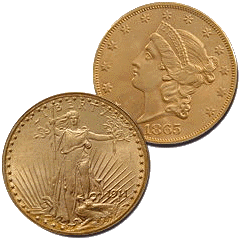
"If you want to know what is really happening, all you have to do is follow the money."
- Unknown
What happened to the $20 Gold Double Eagle is a question you will never hear asked by any "responsible" main stream financial media analysis on TV or in print. Too bad, as why the US $20 Double Eagle is no longer money is a good question that deserves an answer. The US Government stopped using gold as money when it defaulted on its obligations, both foreign and domestic, in the first years of Franklin Delano Roosevelt's administration. A little background first.
The Double Eagle was an ounce of gold minted into the $20 dollar coin by the US Treasury. The minting dies of the US Treasury told people worldwide that this one ounce gold coin was minted by the US Treasury, who guaranteed its purity and weight. In other words the value of the Double Eagle was its one ounce gold content, not its minting by the US Treasury, who only guaranteed the weight and purity of its gold content. Had the Treasury used the same dies it used for a gold Double Eagle but minted a $20 zinc coin, the market during the gold standard era would have treated an American $20 Zinc Double Eagle the same way it treated a Wooden Nickel, a curiosity given to children. With a gold standard, money is gold.
The Treasury dies stamped one ounce of gold into a standard coin which the US Government gave a value of $20. The $20 designation to this one ounce of gold was to facilitate the coin's use for accounting purposes. So if someone said that they had $200 in gold, it was understood that they had ten ounces of gold or ten Double Eagles. But Double Eagles were preferred over ten ounces of gold dust or gold nuggets as Double Eagles were coins of standard weight and purity guaranteed by a Trusted Mint, the US Treasury's Mint.
Hard to understand today, but a $20 paper bill one hundred years ago was only a debt obligation of the US Government to the holder of the $20 bill for $20 in gold coin. Gold Standard monetary policy did not need a Dr. Greenspan to guide it past the rocks and shoals of monetary mishaps. Monetary policy was just that the US Treasury was not to issue more paper dollars than it had gold dollars (coins) to back its paper. Gold Standard monetary policy did not concern itself with interest rates or the purchasing power of the money it managed. Policy was that these were issues best decided by those people who sold things, and to those people who bought things with the government's gold coins or its paper money backed by its gold coins. This was how people understood money, until the Federal Reserve came into being by act of congress in December 1913.
With the Federal Reserve, money matters became uncertain. Looking at old issues of Barron's from the mid 1920's, some ten years after the Federal Reserve was created by the congress, there are articles about how gold coins were no longer circulating in the American economy. Think of the old Morgan silver dollars or one of the new Silver Eagles of today - they also never circulate as money today.
No mystery here. Why would anyone take a coin worth between $10.00, for a 2004 Silver Eagle, or in some cases with the rare older Morgan silver dollars worth over $100,000 and use it to buy a $1 hamburger? If the "monetary policy makers" only assigns these silver dollars a value of $1.00 but everyone knows that they are worth more than that in paper money, people are going to lock them up in a drawer and keep them there. This is why gold stopped circulating as money in the United States in the mid 1920's.
You can be sure that eighty years ago it was understood by the public that paper money was being inflated in excess of the supply of gold money, and that they understood why. This inflation of paper money by the Federal Reserve transformed gold coins from being units of trade into items of collection. Gold was no longer money as paper pushed it out of circulation.
That gold stopped circulating as money years before the 1933 gold crisis, tells me that many people in power, as well as coin collectors, saw and understood what was happening with paper money in the United States. Gresham's law: "bad money drives out good money," was known and taught in colleges for hundreds of years before the 20th century. A point of interest is that Sir Thomas Gresham (1519-79) of Gresham's Law fame, was the advisor for Queen Elizabeth with the monetary policy of England. This was over four hundred years ago. He went on to found Gresham's College in London to educate the merchant class in the Age of Elizabeth. Sir Thomas was a believer in a sound currency as he had lived through times of bad inflation during the reign of King Henry VIII.
In 1922 at Genoa, Italy the "Gold Exchange Standard" was implemented. This convention introduced changes in the international monetary system to allow the use of British pounds and American dollars, as well as gold to settle international trade imbalances. This made paper as good as gold for monetary reserves. This Gold Exchange Standard could work, and did work for as long as there was confidence in the currencies of the United Kingdom and the United States.
However, one of the reasons the "Roaring Twenties" roared was that the United Kingdom and the United States spiking the punch bowl with low interest rates and cheap money, much like the past 10 years. Monetary inflationary boom turned into monetary deflationary bust and confidence in the paper currencies of the United Kingdom and United States were shaken. Foreign creditors (other governments and powerful financial interests who could not be denied payment in gold if they insisted) started to refuse paper pounds and dollars and began demanded gold exclusively for payment. Genoa became another monetary scrap of paper. As we will see shortly, this crisis in the confidence in paper currencies produced some radical actions by the US Federal Government in turbulent years of 1933-34.
Here is a chart to aid in you in understanding what happened to the $20 Double Eagle. My data for these charts are from the old issues of Barron's. The dates given are the date of the Barron's issue where the data would be found. Let's look at my first chart showing data on US Currency in Circulation and the US Gold Reserve from 16 February 1931 to the last week in December 1941, just after the US entry into World War Two.
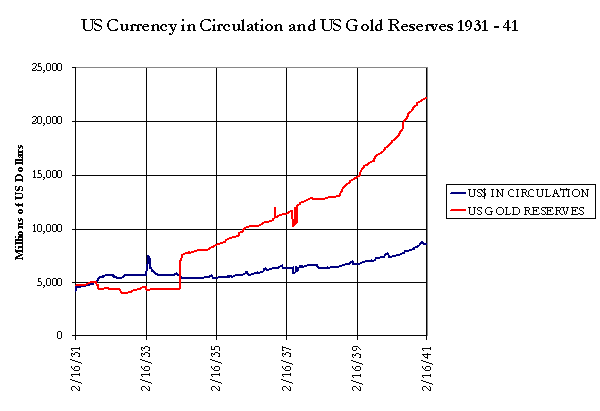
Here we see the weekly data from contemporary issues of Barron's, Currency in Circulation (paper money) in blue and US Gold Reserves in red.
We can see from the chart that sometime in 1931, more paper dollars were issued than there was gold money to support it. This was no longer acceptable as powerful foreign creditors seventy two years ago were refusing American paper dollars and demanding American gold. Note the upward spike in the currency (blue series) in early 1933. This spike corresponds to the peaking of the banking crisis that resulted in the closure of many banks in the United States.
On 5 April 1933, President Roosevelt confiscated all gold held by US citizens with an Executive Order. Americans were to surrender their gold at the pre 1934 rate of $20.67 per ounce of gold. On 30 January 1934, some eight months later (after the government bought tons of gold for only $20.67 in paper for each ounce) the going rate for gold was changed from the old rate of $20.67 to the new rate of $35.00 for an ounce of gold. The effect of this change can clearly be seen in the US Gold Reserves (red series) in the above chart.
So the problem of not having enough gold to back the paper claims was corrected by this one time 42% sneak tax on the assets of the citizens of the United States and those foreigners who held the paper claims to the US Gold Reserves. Note that the people who still had the actual Double Eagles were unaffected by this devaluation of the paper dollar. The Double Eagle may have had $20 stamped on it but it was now worth $35 paper dollars.
What really happened was this:
First; Roosevelt stopped the gold run on the US Gold Reserves by prohibiting Americans from owning gold. This domestic gold prohibition allowed the US Treasury to increase its gold dollars. The now increased gold reserves were then exclusively use to satisfy foreign holders (creditors) of US paper dollars who now demanded gold dollars. So, because the Federal Reserve did not conduct its management of paper money as they promised they would, the American people lost their gold.
Second, the conversion of the gold rate from $20 to $35, forced foreign creditors to now surrender $35 paper dollars instead of the old $20 paper dollars rate, to get the same ounce of US gold. But I suspect that if one were to look at the records, they would see that much of the gold that was shipped over to Europe was done at the pre 1934 rate. There must be records of these transactions and it would be very interesting to see exactly who paid what for the gold that use to belong to our Grandparents. I find it strange that historians often seem unwilling to follow the money in this very significant event in American history. This is especially so when you understand how pressing this issue was seventy years ago.
So, the confiscation of the American people's gold and the devaluation of the paper dollar stopped the run on US Gold, as now there were more dollars in gold than there were dollars in paper. But it was a bad business as it was so dishonest. In the next 70 years, over and over again, the Federal Reserve came to understand that what was bad business was not necessarily bad for its business as long as the Federal Reserve tied its fortune with those elected officials who were in a position to help an old friend in need.
The Roaring 20ies and the Depressing 30ies were brought about by the Federal Reserve mismanagement of the US money supply. America's central bank, the Federal Reserve, made a mess out of things by willfully deviating from centuries old banking practices that were learned from hard experience. France twice in the 18th century was ruined by its flirtations with paper money as was the United States itself with its paper unit of account, "The Continental." The American Constitution of 1789 placed the United States on a bi-metalic (silver and gold) standard to correct the economic and social problems caused by paper money.
The Federal Reserve system was promoted to the American people and chartered by the Congress so the banks could provide a "flexible currency" that they claimed would better serve industry and trade than inflexible gold. A fair review of what happened to the economy of the United States in the first twenty years of Fed's management of their "flexible currency" proved that they were wrong. The Federal Reserve caused the greatest boom, The Roaring 20ies, and the greatest bust, The Great Depression, in the 144 year history of the Republic. The Federal Reserve should have had its charter revoked and had its "flexible" Federal Reserve Notes removed from circulation.
However, President Roosevelt, in 1933, saw the political advantage in saving the Federal Reserve System. For whatever reason, he was determined to pursue a policy of monetary inflation to solve the problems caused by monetary inflation; fighting fire with fire. After all, passing out money always makes more friends than enemies, if passed out wisely. A gold standard stood in the way of this political largesse. As the Federal Reserve would only be too willing to help in making America whole again with yet one more bout of paper dollar inflation, Roosevelt gave them a second chance.
In the contest between paper or gold as money for the United States currency in the early 1930's, gold lost as gold limits the power of government. President Roosevelt, like most politicians wanted political power. So, paper as money was the politically astute choice of currency for a president who wanted to make lots of "policy." But a return to gold as money, and the discipline it imposed on banking and government, would have been the right thing to do.
"Where would we be if we had I.O.U.'s scrip and certificates floating all around the country?" Instead he decided to "issue currency against the sound assets of the banks. [As opposed to issuing currency against gold.] The Federal Reserve Act lets us print all we'll need. And it won't frighten the people. It won't look like stage money. It'll be money that looks like real money."[Emphasis added.] (Source: 'Closed for the Holiday: The Bank Holiday of 1933', p20 - Federal Reserve Bank of Boston)
There were no more $20 Double Eagles minted after 1932. Any Double Eagles Roosevelt could get his hands on were melted down into 25 pound bars of gold. These heavy bars of gold were sent to the newly built gold bullion storage facility at Fort Knox, Kentucky where the US Army Tank Corps guards them. If they are missing it will not be due to unauthorized thief by persons unknown. As unauthorized thief is really impossible the US Gold should still be there, right? However, as there has not been a proper audit of the US Gold Reserves since the 1950's, it is time to perform an independent audit of the American people's gold.
"Of all the contrivances for cheating the laboring classes of mankind, none has been more effective than that which deludes them with paper money."
- Daniel Webster
What Happened to the Bretton Woods Accords?
The next period of interest is late 1944, the Bretton Woods Accords (BWA). The BWA placed the post World War Two world on a US dollar standard with US paper dollars convertible between central banks at $35 for an ounce of gold. It is from Bretton Woods that the American dollar became the "World's Reserve Currency" and when the International Monetary Fund (IMF) and the World Bank was created to maintain the new dollar standard. After Bretton Woods, gold no longer circulates as money anywhere. All currencies were to be fixed to the new Reserve Currency - the US Federal Reserve created dollars. Bretton Woods was a treaty ratified by the US Senate, thus The Bretton Woods Accords became American law, binding on the "policy makers" of the United States of America.
So why can't foreign central banks convert their US dollar holdings into US gold anymore? Let us now look at my chart plotting US Currency in Circulation and US Gold from 1931 to 1971.
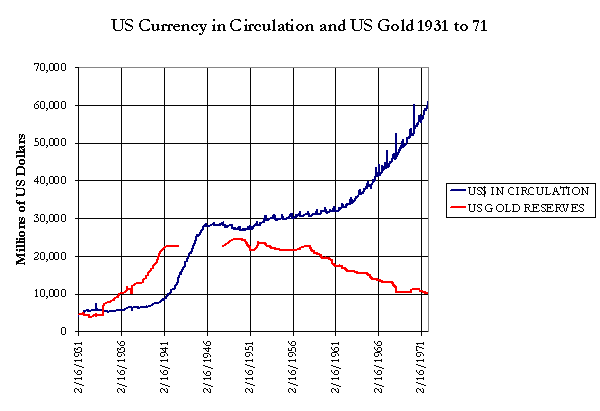
I find the above chart absolutely damning, proof positive that you cannot trust the word of American "policy makers" when it comes to "monetary policy." Looking at the above chart, it is clear that the ink was dry on the Bretton Woods Accords for only five or six years before the Federal Reserve and the US Treasury started creating currency in excess of what the United States Gold Reserves could justify. Legally, this was no different than if you or I wrote checks for payment of goods and services we wanted from a checking account that we knew had insufficient funds. No one in the US Congress stopped them. Congress, after all, has the constitutional authority and obligation to regulate the value of the American dollar, NOT the US Treasury or the Federal Reserve!
"The moment that government appears at the market, the principle of the market is subverted."
- Edmund Burke (1729-97)
I could find no record in Barron's, from forty years ago, of congressional hearings discussing the issue of rampant dollar creation in excess of US Gold Reserves. However, there are plenty of articles on the world's problems with the US dollar in Barron's. Congress has the responsibility of Executive Oversight from the Constitution. When the US Treasury and the Federal Reserve were not keeping to the terms of an important treaty, and in a very public way, (my chart data after all is from contemporary issues of Barron's!) I would think this lawless behavior by the US Treasury and the Federal Reserve would have been a point of concern with the law makers. I have to believe the Congress did know what was happening with "monetary policy" but turned a blind eye on these gross violations of their statutes for political reasons.
This was the period of President Johnson's "Great Society" and "Great Societies" require great amounts of money. There was also the Vietnam War and NASA too needed billions of dollars to put a man on the moon. When politicians want money, and lots of it, as Roosevelt did in 1934 and as Johnson did 30 years later, they knew it best not to ask where it was coming from. As Congress did not inquire about excessive currency creation in 1934 or 64, it is fair to say that the Congress too took some pleasure in this monetary sin. If the Congress did not ask then, it is doubtful that they are going to start asking now, decades after a sound gold dollar has been forgotten by most of mankind. I need to note that there were some individual congressmen and senators who opposed the assault on the gold US dollar.
"When you recall that one of the first moves by Lenin, Mussolini, and Hitler was to outlaw individual ownership in gold, you begin to sense that there may be some connection between money, redeemable in gold, and the rare prize known as human liberty."
- Congressman Howard Buffett (Father of Warren Buffett) from a 1948 issue of the Commercial and Financial Chronicle
"A billion here, a billion there, and pretty soon we are talking about real money!"
- Senator Everett Dirkson
Amazingly, foreign central banks in the 1960's started what was called the London Gold Pool. The London Gold Pool member central banks used THEIR OWN NATION'S GOLD RESERVES TO DEFEND THE AMERICAN DOLLAR'S $35 AN OUNCE OF GOLD PEG. Why? Wasn't defending this $35 an ounce peg the American responsibility? Since World War Two, there has been a documented history of foreign central banks coordinating their management (selling their nation's gold) to support American "monetary policy." Bretton Woods died because everyone with any lawful authority with global "monetary policy" refused to defend this important law protecting their society from the fraudulent unit of account known as the American dollar. One only has to read the issues of Barron's from this period to see what the London Gold Pool was doing. Instead of insisting that the issuer of the global reserve currency uphold its legal obligations, members of the London Gold Pool assisted in the fraud of the $35 an ounce monetary gold peg against the interest of their own nations. Why did they do this? This is a question too that historians of the 20th Century seem never interested in asking.
Years from now researchers will find our current issues of Barron's an excellent source of data on what central banks of our era used their gold for. Recorded in its pages is when this or that central bank sold its nation's gold reserves to support a lower gold price, and stronger US dollar the "policy makers" deemed necessary. But you will have to read between the lines to read what the real story was. Barron's, like most of today's financial journalist are more than willing to pass on the "policy" line that this or that central bank sold its gold as gold was a "dead asset", as it did not pay interest. Seldom will you read the possibility of the much more likely case of central banks selling their nations gold to support the American dollar. Why?
There is a difference between the reporters and editors of Barron's today and those of decades ago. Decades ago, Barron's didn't just parrot what "policy makers" told them in their reporting of banking issues. Barron's reported what it knew was true. Since Alan Abelson stopped being the executive editor of Barron's, I believe the quality of its reporting of financial matters has suffered. I really believe that I have learnt more of today's world reading past issues of Barron's than its current issues. Many articles of decades ago were written with an eye to the future; all too many of their predictions have come true.
To be fair with today's Barron's contributors I have to add that they grew up in different times than the now long dead Barron's reporters. The past writers lived in a time when gold was remembered to be the honest unit of account, where as today's financial reporters have lived only in a world where gold was as dead as a dinosaur and the Federal Reserve lords over the world's markets. But I digress from Bretton Woods.
Bretton Woods was an international treaty ratified by the United States Government. The Bretton Woods Accords was the law of the United States. Ethical public officials charged with "monetary policy" would have conducted their activities so that the United States management of the world's Reserve Currency would have complied with the Bretton Woods Accords. That meant that the United States would never issue more currency than it could back with its gold reserves, thus allowing foreign central banks to convert their excess Federal Reserve Notes (US dollars), the world's Reserve Currency, into US gold at a $35 an ounce rate upon demand.
This was how things were done since Napoleon lost at Waterloo, and how the world, if not the world's central banks, expected the United States to manage its responsibility as the issuer of the world's Reserve Currency. In the above chart one can clearly see the trend that started in 1951 that would culminate with President Nixon closing the gold window in August 1971, creating an era where for the first time in the history of mankind, gold was not used as money anywhere on planet Earth. The American currency became a world problem.
For the next few years, the world's "policy makers" tried to maintain an international monetary system with currencies pegged to the US dollar. But with the Federal Reserve, the US Congress and President directing "monetary policy" (and setting the example of how to print money) this period of fixed currencies, unsupported with gold, did not last long. In September 1975, Barron's started publishing the now floating exchange rates of currencies in the world, and Currencies do fluctuate, some extremely so.
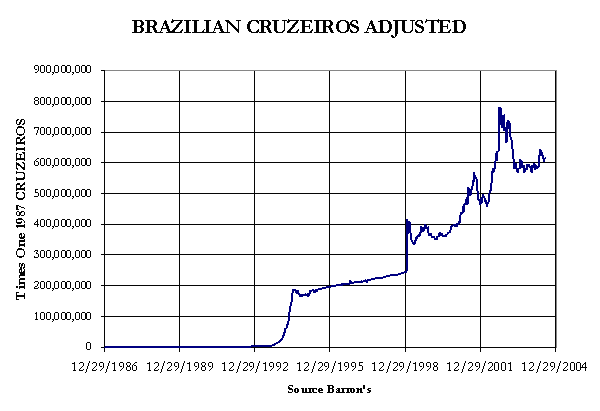
In 1986, Brazil's currency was called the "Cruzeiros", it is now called the "Real." I have not charted the actual currency exchange rate published in Barron's but how many more units of currency Brazil has increased its money supply with a basis of 1.00 starting in 1986. The above is an example of hyperinflation.
We entered a world where international concerns, conducting business across boarders, had to deal with a risk they never had to deal with before, currency fluctuations. Here is the genesis of the hundred trillion dollar derivatives market used to "hedge risks" that were not present before 1971.
In one sense Bretton Woods may have succeeded beyond all expectations, in a Doctor Evil sort of way. * If * "policy makers" at the beginning in 1944 set out to create a monetary system that had no limits placed upon its creation of credit and currency, that had two huge organizations dedicated to enforce "international monetary policy" behind an international fraudulent unit of account, then, without the US dollar link to gold and the freeing of currencies from their fixed rates pegged to the dollar, what was once the Bretton Woods Accords has risen from the grave and became a monetary zombie capable of anything but prudence. It goes without saying that I do hope this is not the case. But examining the history of what was promised by the "policy makers" and then seeing what they delivered, I would not rule this possibility out.
The start of "flexible" national currencies rates in the early 1970's was heralded as a great advancement in the science of "monetary policy." "Flexible" currencies provided "policy makers" elbow room in executing "policy." However, at best that must have been face saving propaganda from people who knew they made a mess of things - at worse the introduction of flexible currencies were an evil machination. In either case, "policy makers" knew the reality of it all, that they took billions of people into a new world whose consequences they could not have fully understood, consequences that have yet to be fully revealed to the world.
Here is the chart of US Currency in Circulation and US Gold Reserves from 1931 to present. It is nothing to be proud about.
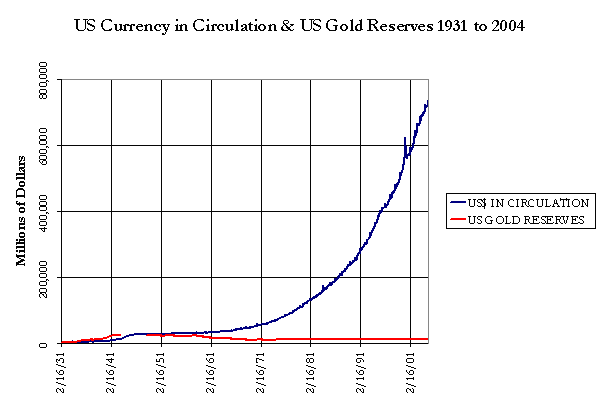
The above chart will tell you better than I ever could, what happened to the American $20 Double Eagle gold coin and the Bretton Woods Accords. This chart also tells you how effective gold was on restraining "policy makers" from over issuing a currency, thus checking the forces of inflation. Note that after Nixon closed the gold window in August 1971 to foreign central banks, US Currency production went into high gear. Also, foreign central banks that used to be able to exchange their excess US dollars for US Gold, now had to exchange their Federal Reserve created dollars for US Treasury Bonds. This is most significant.
The current scheme of having US Treasury Bonds (debt) for international monetary reserves allows the US Treasury to spend the same dollar again and again when foreign central banks present the US Treasury their excess US dollars! It is like someone going to a shop, using credit to buy an item and have the merchant gave them both the item and money in the amount of the purchase back! The only thing the merchant has to show for this financial transaction it is yet one more IOU from this peculiar customer. This farce could never exist with gold based reserves, as gold, unlike the US Treasury's debt based reserves, are limited. When the customer ran out of gold, they ran out of money. In the 20th century, American "policy makers" had no use for gold. Absolutely none.
As you can see in the above chart, in 1971 Currency in Circulation took off skyward. What was to stop the Federal Reserve from creating more and more paper money or American politicians from spending it? Not the American voters who were getting low interest rate mortgages on homes whose valuations only seemed to ever rise upwards in dollar terms. Our world with its cheap credit for the masses, and quarter million dollar mortgages for homes that were made for $25,000 thirty years ago, was made possible with the removal of gold from our money. It may have been good up to now, but the history of currency inflation strongly suggests this is a situation that will end, and end badly.
"So far as I can discover, paper money systems have always wound up with collapse and economic chaos."
- Congressman Howard Buffett.
What Should be a Fair Price for Gold Today?
As we saw in the first chart that Roosevelt prohibited domestic gold ownership and raise the price of one ounce of gold from $20 in Federal Reserve Notes to $35 in Federal Reserve Notes to bring the system into a favorable balance in 1934. A question occurs to me. What if the United States once again saw gold as money in its best interest, and resolved to take steps to reintroduce the pre Federal Reserve Gold Standard. How many dollars would they have to raise the official gold price to fully back the American dollars now in circulation with its gold reserves?
As a gold standard demands that anyone holding a paper US dollar note could take their paper dollar note to any bank and demand exchange of their paper dollars for gold dollars, we need to know how many paper dollars are outstanding (Currency in Circulation) and how many dollars, not ounces, of gold the US Government has to redeem this paper with. In other words, the number of paper dollars, must equal the number of gold dollars the Treasury has to back its paper dollars. With a gold standard, these lines need to be equal to each other at all times. As these lines do not now equal each other, this shows what happens when paper money is allowed too grow unrestrained by a link to gold.
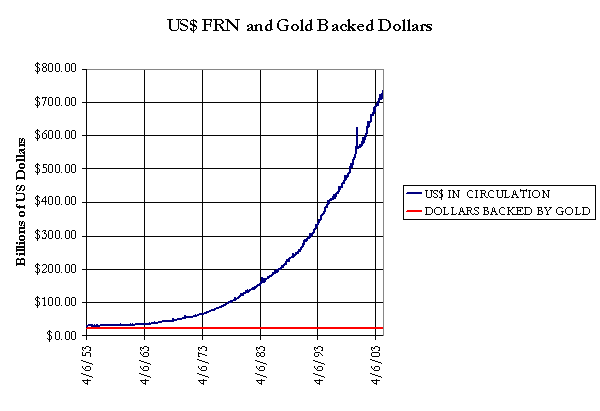
The above chart shows the US Treasury's own statistics for Currency in Circulation and its gold reserves in dollars @ $42 an ounce. I want to stress that this chart is a chart of dollars paper (blue) and dollars gold (red). To make the red gold dollar line rise up to the blue paper dollar line, the US Treasury only has to raise its official price of gold up so the red gold dollar line will met with the blue paper dollar line. The Government must then stop printing paper dollars that they can not support with their dollar gold coins, simple. This is no different from what we saw in 1934 with the first chart in this article when Roosevelt raised the price of gold up from $20 to $35 dollar an ounce. But Roosevelt raised gold from $20 to $35, where must today's "policy makers" raise the official price of its gold, which now is valued at an official price of $42 an ounce.
If we were to return to a gold standard where holders of paper dollars could demand gold dollars for their paper dollars, the United States Government would have to raise the official price of gold to a substantially higher price than the current $42 an ounce. How high? For the red line on the above chart to cross the blue line on the above chart, the official US gold price would have to rise up to around $2,800 an ounce. Just as important, the US Treasury and its agent, The Federal Reserve, would have to stop issuing paper money not supported by its gold. "Monetary policy" would no longer consist of manipulating interest rates, money supply or targeting prices of critical economic items. Gold Monetary Policy is very simple - just keep these two lines equal, and don't answer any phone calls from politicians, widows, orphans, or victims of natural disasters. I said Gold Standard Monetary Policy is very simple, not very easy.
A gold standard monetary policy would, by policy, ignore market driven interest rates and prices of politically sensitive goods and services even during the election years. For this reason, a return to the gold standard will not happen as a result of internal debate in the halls of power of the US Government as the implications for American "policy makers" of returning to a gold standard are monumental. A return to a true gold standard would place a true and absolute limit on "policy" and the world is not ready for that just yet.
Returning to honest money will only happen when events force this issue to the extent where the "policy makers" see that life without gold as money has become more painful than life with gold as money. In other words, when the US dollar and other fiat currencies are not accepted for payment by the world, but gold is, you can expect the "policy makers" the world over to become enthusiastic about gold as money again, but not before.
So how did I come up with the figure of around $2,800 an ounce for a new gold standard? I took the number of US dollars in Circulation and the number of ounces of US Gold the US Treasury claims to have. The amount of US Gold in ounces is derived by dividing "US Gold Reserves" by the US Government's official price of their gold of $42. Currently the US Treasury claims to have 11 billion in gold @ $42 an ounce. Divide that 11 billion by $42 and we see that the US Treasury claims to have around 262 million ounces of gold. It should be noted that those 262 million ounces of US gold have not been audited in fifty years. With gold, much can happen in fifty years.
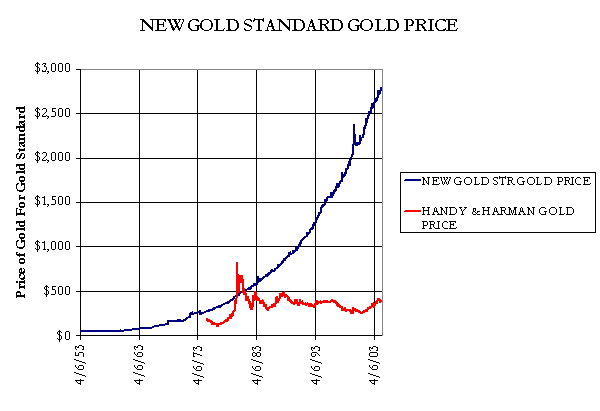
The blue plot line is the weekly value in dollars per ounce of gold that the US Treasury would have to revalue their gold reserves to make dollars paper = dollars gold, from 1953 to present. Assuming that there are not more Federal Reserve Notes than the Federal Reserve says there are, and that there is not less US Gold than the US Treasury claims it has - US Gold that is free and clear from third parties claims, it would require the US Government to revalue its gold at a price of around $2,800 an ounce, for now.
I've included the Handy & Harman spot gold price in the chart above. This allows us to compare a market based, if manipulated gold price (red series), with my derived Needed Gold Standard Price (blue series). I think it noteworthy that when the Handy & Harman gold price was peaking in the last gold bull market, 1979-80, the Handy & Harman price of gold exceeded my derived Needed Gold Standard Price price. Looking at the Handy & Harman spot gold price (red series) from 1973 to 1983, we see that in the late 1979 to early 1980 that the spot gold price rose above and then collapsed below my derived Needed Gold Standard Price of gold (blue series). This rising above my derived Needed Gold Standard Price of gold and then collapse below it by the Handy & Harman gold spot price gives me confidence that my plots on the Needed Gold Standard Price are valid. I believe this chart provides an excellent measure on the relative over or under valuation of the price of gold relative to the US Dollar. Right now gold is very cheap and getting cheaper.
Going back to late 1979-early 80, with the market price of gold above my derived Needed Gold Standard Price of gold (the dollar price the US Government would need to have its claimed gold reserve cover its Currency in Circulation) gold was clearly overvalued. It must be noted too, that in the early 1980's, all US long bond yield rates were double digit. The US had a bond maturing in November 2001 with a 15.75% coupon. You only have to look in an old issue of Barron's to see this particular 20 year bond. To save you some effort, the current issues of Barron's bond tables still lists many US Treasury bonds paying a double digit junk bond coupon. These bonds are like the fossil remains of a time when gold was going for over $800 an ounce and the US dollar was a problem currency. The world was fleeing the dollar and going for the gold.
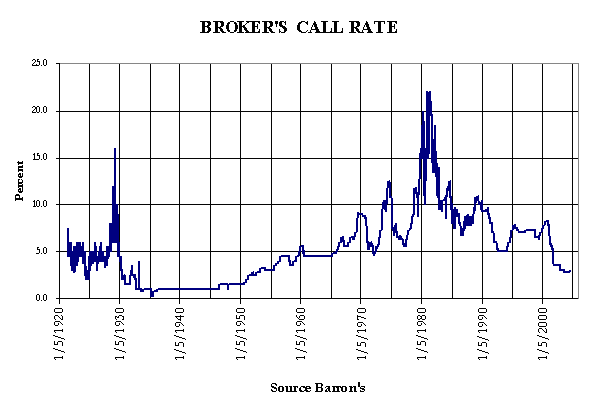
I don't have yield data for the US long bond yields. I do have this chart of the Broker's Call Money rate from 1920 to present. This is showing the history of 84 year of US short term interest rates. Clearly any debt instrument that has to pay a double digit current yield to clear the market is a junk credit. In 1980, with double digit long US Treasury debt and with short rates over 20% there was no debt instrument payable in US dollars whose current yield was less than double digits on the entire spectrum of the US yield curve. Realize too that money was then historically tight when gold last peaked in the early 1980's. Had there been a large "carry trade" in 1980, this tight money would have ruined them.
In 1980, with over priced gold and the US Treasury willing to pay junk bond rates on its bonds, bonds that were not then, and are not now callable, the international financial markets were given enough incentive to leave gold and come back to the dollar. $840 an ounce gold and +12%, on the 20 year Treasury yields broke the back of the gold run in 1980. If the market itself decided to take gold to somewhere over $1,000 an ounce sometime in the not to distance future, how high would short and long term US interest rates have to rise to bring people back on the dollar plantation? There are implications here I have not addressed in this article, but if interest rates were just to return to where they were in 1980 our world would be a different place.
After 1980, for the next twenty years, the flood of money coming from the US monetary system went into financial assets instead of real assets. Interest rates went from historic highs to much lower levels, gold and silver went down, commodities traded in a range, crude oil was plentiful and cheap. Clearly since 1980 financial assets were the place to be. But in 1980 this was not apparent to most people, like me. Back then, those "experts" talking to the mass market of investors were talking about oil shortages, ever higher interest rates and $2,000 gold. I think those "experts" of twenty years ago were right, they were just twenty years too early.
Mark J. Lundeen
















